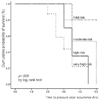Abstract
Purpose
This study was done to identify the time interval to pressure ulcer and to determine the optimal time interval for position change depending on pressure ulcer risk in patients using foam mattress in intensive care units.
Methods
The Braden scale score, occurrence of pressure ulcers and position change intervals were assessed with 56 patients admitted to an intensive care unit from April to November, 2011. The time to pressure ulcer occurrence by Braden scale risk group was analyzed with Kaplan-Meier survival analysis and log rank test. Then, the optimal time interval for position change was calculated with ROC curve.
Results
The median time to pressure ulcer occurrence was 5 hours at mild or moderate risk, 3.5 hours at high risk and 3 hours at very high risk on the Braden scale. The optimal time interval for position change was 3 hours at mild and moderate risk, 2 hours at high and very high risk of Braden scale.
References
1. Agency for Health Care Policy & Research. Clinical practice guideline. 1992. Retrieved November 17, 2011. from http://www.ncbi.nlm.nih.gov/books/NBK63910/#A4552.
2. Ayello EA, Braden B. How and why to do pressure ulcer risk assessment. Adv Skin Wound Care. 2002. 15:125–131.
3. Bennett G, Dealey C, Posnett J. The cost of pressure ulcers in the UK. Age Ageing. 2004. 33:230–235. http://dx.doi.org/10.1093/ageing/afh086.
4. Bergstrom N, Braden BJ. Predictive validity of the Braden scale among black and white subjects. Nurs Res. 2002. 51:398–403. http://dx.doi.org/10.1097/00006199-200211000-00008.
5. Bergstrom N, Braden B, Kemp M, Champagne M, Ruby E. Predicting pressure ulcer risk: A multisite study of the predictive validity of the Braden scale. Nurs Res. 1998. 47:261–269.
6. Bergstrom N, Demuth PJ, Braden BJ. A clinical trial of the Braden scale for predicting pressure sore risk. Nurs Clin North Am. 1987. 22:417–428.
7. Braden BJ, Maklebust J. Preventing pressure ulcers with the Braden scale: An update on this easy-to-use tool that assesses a patient's risk. Am J Nurs. 2005. 105:70–72.
8. Defloor T. The effect of position and mattress on interface pressure. Appl Nurs Res. 2000. 13:2–11. http://dx.doi.org/10.1016/S0897-1897(00)80013-0.
9. Defloor T, De Bacquer D, Grypdonck MH. The effect of various combinations of turning and pressure reducing devices on the incidence of pressure ulcers. Int J Nurs Stud. 2005. 42:37–46. http://dx.doi.org/10.1016/j.ijnurstu.2004.05.013.
10. European Pressure Ulcer Advisory Panel & National Pressure Ulcer Advisory Panel. Pressure ulcer prevention: Quick reference guide. 2009. Retrieved April 7. 2011. from http://www.npuap.org/Final_Quick_Prevention_for_web_2010.pdf.
11. Gorecki C, Closs SJ, Nixon J, Briggs M. Patient-reported pressure ulcer pain: A mixed-methods systematic review. J Pain Symptom Manage. 2011. 42:443–459. http://dx.doi.org/10.1016/j.jpainsymman.2010.11.016.
12. Hagisawa S, Ferguson-Pell M. Evidence supporting the use of two-hourly turning for pressure ulcer prevention. J Tissue Viability. 2008. 17:76–81. http://dx.doi.org/10.1016/j.jtv.2007.10.001.
13. Halfens RJ, van Achterberg T, Bal RM. Validity and reliability of the braden scale and the influence of other risk factors: A multi-centre prospective study. Int J Nurs Stud. 2000. 37:313–319. http://dx.doi.org/10.1016/S0020-7489(00)00010-9.
14. Jun Seongsook RN, Jeong Ihnsook RN, Lee Younghee RN. Validity of pressure ulcer risk assessment scales: Cubbin and Jackson, Braden, and Douglas scale. Int J Nurs Stud. 2004. 41:199–204. http://dx.doi.org/10.1016/S0020-7489(03)00135-4.
15. Keller PB, Wille J, van Ramshorst B, van der Werken C. Pressure ulcers in intensive care patients: A review of risks and prevention. Intensive Care Med. 2002. 28:1379–1388. http://dx.doi.org/10.1007/s00134-002-1487-z.
16. Kottner J, Dassen T. Pressure ulcer risk assessment in critical care: Interrater reliability and validity studies of the Braden and Waterlow scales and subjective ratings in two intensive care units. Int J Nurs Stud. 2010. 47:671–677. http://dx.doi.org/10.1016/j.ijnurstu.2009.11.005.
17. McInnes E, Jammali-Blasi A, Bell-Syer SE, Dumville JC, Cullum N. Support surfaces for pressure ulcer prevention. Cochrane Database Syst Rev. 2011. (4):CD001735. http://dx.doi.org/10.1002/14651858.CD001735.pub4.
18. Ministry of Health and Welfare, Korea Institute for Healthcare Accreditation. 2011 Healthcare accreditation survey guidebook (ver 1.2)-for large hospitals with 300 and over beds. 2011. Retrieved May 24, 2012. from http://www.koiha.or.kr/home/data/data/doView.act.
19. National Pressure Ulcer Advisory Panel. Pressure ulcer stage. 2007. Retrieved May 24, 2012. from http://www.npuap.org/pr2.htm.
20. National Pressure Ulcer Advisory Panel, European Pressure Ulcer Advisory Panel (NPUAP & EPUAP). Pressure ulcer treatment recommendations. Prevention and treatment of pressure ulcers: Clinical practice guideline. 2009. Retrieved May 24, 2012. from http://www.guideline.gov/content.aspx?id=25139&search=pressure+ulcer.
21. Pancorbo-Hidalgo PL, Garcia-Fernandez FP, Lopez-Medina IM, Alvarez-Nieto C. Risk assessment scales for pressure ulcerprevention: A systematic review. J Adv Nurs. 2006. 54:94–110. http://dx.doi.org/10.1111/j.1365-2648.2006.03794.x.
22. Ratliff CR. WOCN's evidence-based pressure ulcer guideline. Adv Skin Wound Care. 2005. 18:204–208.
23. Reddy M, Gill SS, Rochon PA. Preventing pressure ulcers: A systematic review. JAMA. 2006. 296:974–984. http://dx.doi.org/10.1001/jama.296.8.974.
24. Russell LJ, Reynolds TM, Park C, Rithalia S, Gonsalkorale M, Birch J, et al. Randomized clinical trial comparing 2 support surfaces: Results of the prevention of pressure ulcers study. Adv Skin Wound Care. 2003. 16:317–327.
25. Theisen S, Drabik A, Stock S. Pressure ulcers in older hospitalised patients and its impact on length of stay: A retrospective observational study. J Clin Nurs. 2012. 21(3-4):380–387. http://dx.doi.org/10.1111/j.1365-2702.2011.03915.x.




 PDF
PDF ePub
ePub Citation
Citation Print
Print







 XML Download
XML Download